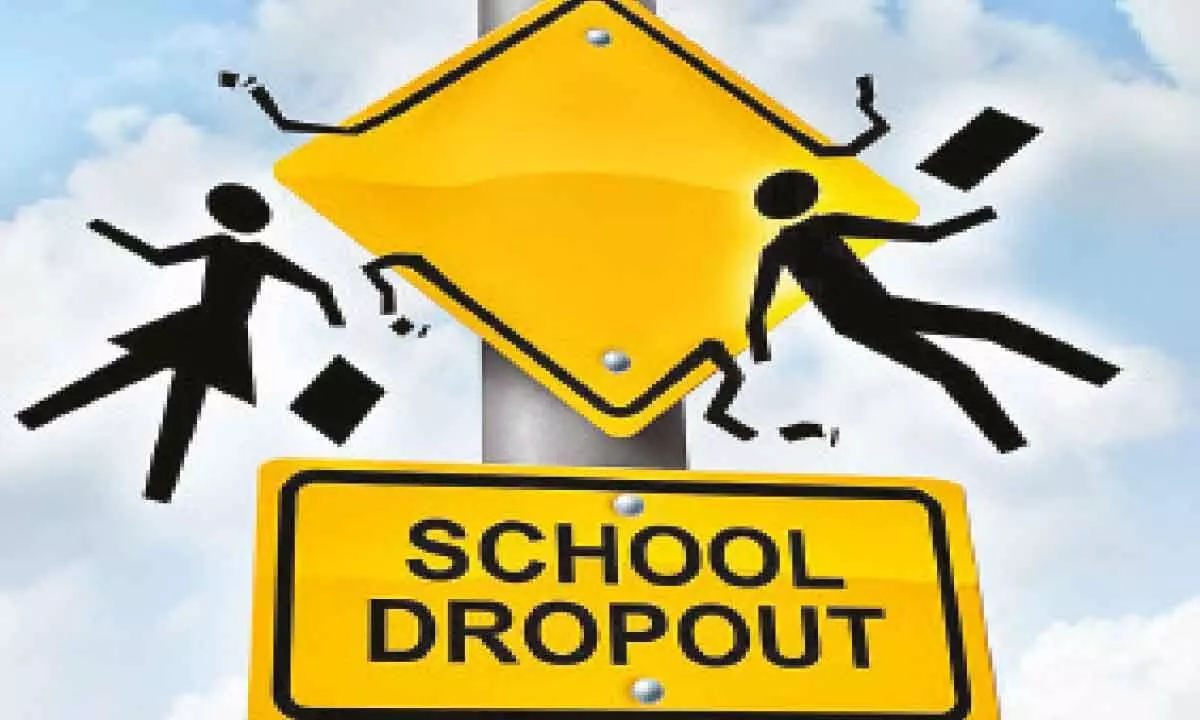Very agonising to see high dropout rate among students after school education

Most students are from weaker sections, children of workers in unorganized sectors and farm labourers
Many students don’t opt for higher studies after completing their primary to higher secondary education. Either they withdraw themselves or discontinue studies if they do not clear the Class XII board examination. It is a serious issue and needs prompt interventions of the powers-that-be at the Centre and in States.
It is also a great opportunity for all those who are engaged in realizing the goal of inclusive Viksit Bharat by 2047 to handhold them, as a majority of them, I presume, are students from weaker sections, children of workers in unorganized sectors and farm labourers. Some of them could also be children of gig workers in smaller towns and semi-urban areas.
The official data offers an insight into what kind of corrective measures are required. The Union Ministry of Education had on November 3, 2023 released a detailed report on Unified District Information System for Education Plus (UDISE+) 2021-22 on India’s school education. It says that in 2021-22, total students enrolled in school education from primary to higher secondary stood at 25.57 crore as compared to 25.38 crore in 2020-21, registering an increase of 19.36 lakh enrolments. Total number of Scheduled Caste (SC) enrollment increased to 4.82 crore in 2021-22 as compared to 4.78 crore in 2020-21. Similarly, total Scheduled Tribe (ST) enrollment increased to 2.51 crore in 2021-22 from 2.49 crore in 2020-21. The strength of other backward class (OBC) students also increased to 11.48 crore in 2021-22 from 11.35 crore in 2020-21.
The (UDISE+) 2021-22 report also says that the total number of schools stood at 14.89 lakh as compared to 15.09 lakh in 2020-21. This decline is mainly due to closure of private and other management schools and grouping/clustering of schools by various States. In terms of availability of basic infrastructure facilities in 2021-22, 89.3 per cent schools have electricity connection and 98.2 per cent have drinking water. There are toilets for girls in 97.5 per cent schools, child with special needs (CWSN) toilets in 27 per cent, hand wash facility in 93.6 per cent, playground 77 per cent, ramp with handrail for CWSN in 49.7 per cent schools, while 87.3 per cent schools have library, reading room and reading corner. These are certainly impressive figures but what worries us the most is the fact that only a small percentage of school students are able to enroll themselves into higher education institutions (HEIs) and the number of those from weaker sections of society is quite low further underscoring the pressing need to drive them towards colleges and universities.
As we are gearing up to achieve the goal of 50 per cent GER in higher education by 2030, let us identify families which have not produced even a single graduate so far, that is, even after nearly eight decades of Independence. It is an easier task to be done. We have the data of about 81.35 crore beneficiaries of free food grains under the Pradhan Mantri Garib Kalyan Anna Yojana (PMGKAY), the world’s biggest social welfare scheme.
The Central and state governments should formulate a scheme to pick the children studying in Class X to XII from among beneficiary families and get them enrolled in HEIs. It is not a herculean task but certainly requires a strong political will power and an unwavering sense of commitment to the idea of inclusivity. The challenge is not only to achieve the stipulated figure of 50 per cent GER in higher education but also to increase its social ambit.
I can foresee a greater role for private sector HEIs in this regard. They can voluntarily admit 25 per cent students from non-graduate families and should admit other poor students only when some seats are left vacant. Since most private institutions are being run as business models, and not as charitable entities, they would certainly require some financial assistance, which they will get through government scholarships on offer for poor students. A portion of their expenses should also be borne by the institutes by providing free accommodation to them, while their food could be financed from the corporate social responsibility (CSR) funds. Industrial bodies like CII, FICCI and PHD Chamber of Commerce and Industry should also come forward to help them.
There is no point in turning a blind eye to the writings on the wall. We know so well that without imparting quality higher education to the masses, we cannot achieve the goal of inclusive Viksit Bharat by 2047. Just being a $ 30 trillion economy won’t serve the purpose if monstrous economic and income disparities persist, and the majority of people are devoid of the ease of quality life. Wealth concentrated in the hands of a few will only exacerbate social tensions, hinder sustainable development, and perpetuate poverty for the majority. We must ensure that benefits of a burgeoning economy are accessible to all and none of us is denied essential amenities, healthcare, education, and overall quality of life. We cannot build a vibrant Bharat just by increasing the size of the economy but only by enhancing people’s living standards.
So, we need a robust economy which ensures inclusive growth, which won’t be possible without imparting useful quality education to the masses. In Japan, the percentage of 18-year-old population bracket students enrolling in universities and junior colleges has steadily increased since World War II to exceed 50 per cent as of now. If the percentages of students enrolling in colleges of technology and specialized schools are added, the total percentage exceeds 70 per cent. Judging from this situation, one assumes that Japan has already entered the stage of universal access to higher education.
In India, we are certainly not talking of making quality and affordable higher education to all but the pace of improving the quality, affordability and reach of higher education must be increased.















